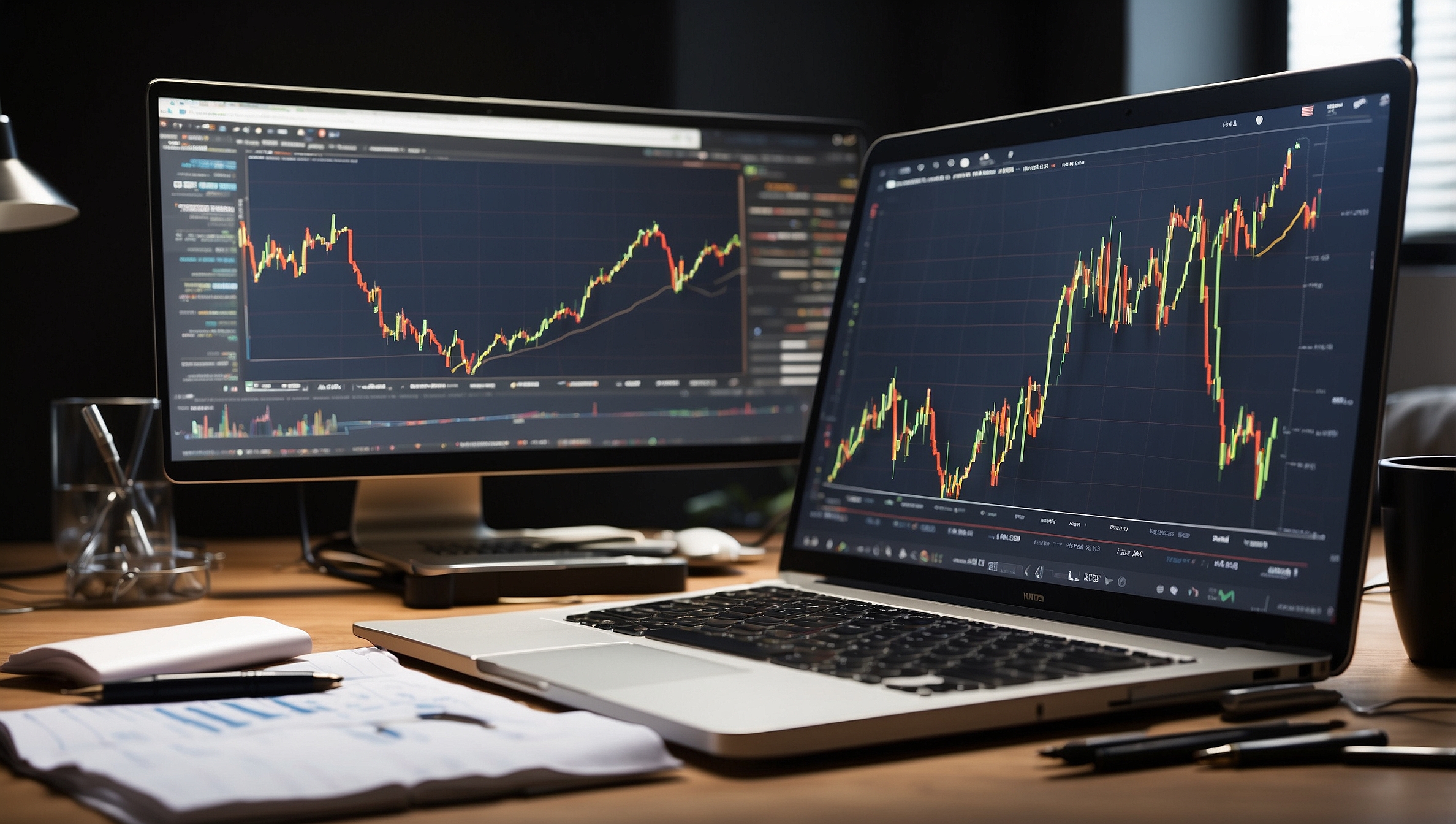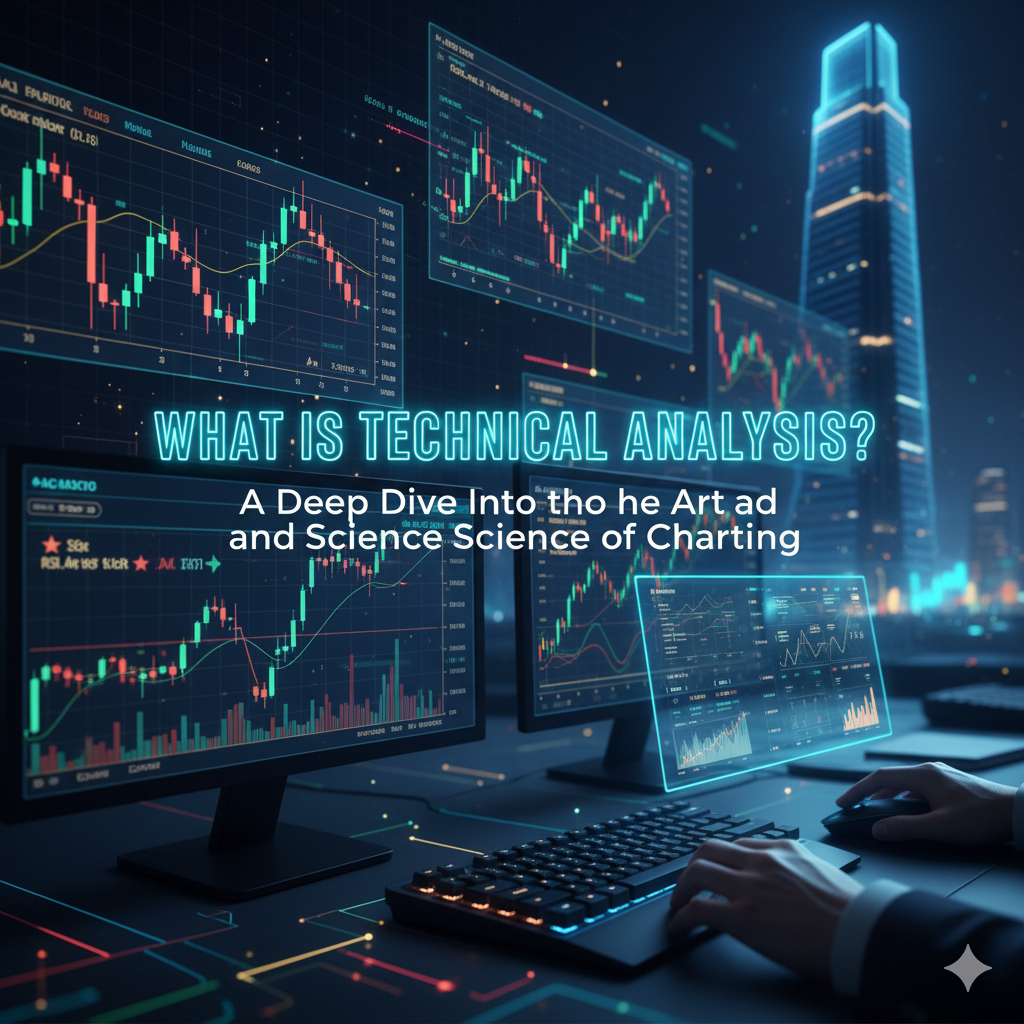In the vast universe of financial markets, two rival schools of thought have long competed for the allegiance of traders and investors: Technical Analysis and Fundamental Analysis. This is more than just a difference in methodology; it’s a profound philosophical divide about what truly drives market prices. Is it the intrinsic value of a company, its earnings, and its position in the economy? Or is it the raw, unfiltered data of price and volume, driven by the timeless emotions of fear and greed?
The debate between these two disciplines is the central intellectual conflict in finance. On one side, you have the “Fundamentals,” who act like financial detectives, poring over balance sheets, income statements, and economic reports to deduce a company’s true worth. On the other, you have the “Technicians,” or “Chartists,” who act like market psychologists, studying price charts to decipher the behavior of the crowd.
But is this a zero-sum game? Must one be right and the other wrong? Or can these two opposing views be reconciled?
This definitive guide will explore every facet of the technical vs. fundamental debate. We will dissect the core philosophies, methodologies, strengths, and weaknesses of each approach. We will examine who uses them, for what purpose, and ultimately, how a modern trader can synthesize the best of both worlds to gain a powerful competitive edge.
Defining the Core Philosophies: Value vs. Price
To understand the difference between technical and fundamental analysis, we must first grasp their core philosophies. They are trying to answer two very different questions.
Fundamental Analysis Asks: “What is this asset’s intrinsic value?”
Fundamental analysis is the art and science of determining the “true” or “intrinsic” value of an asset. The fundamental analyst believes that every security has an objective value based on the financial health and future prospects of the underlying company or economy. The current market price can, and often does, deviate from this intrinsic value.
The goal of the fundamental analyst is to calculate this intrinsic value and compare it to the current market price.
- If the market price is below the intrinsic value, the asset is considered undervalued and is a “buy.”
- If the market price is above the intrinsic value, the asset is considered overvalued and is a “sell” or “short.”
The core belief is that, over the long term, the market price will inevitably converge with its fundamental value. It is a patient approach, grounded in economics, accounting, and business management.
Technical Analysis Asks: “What is the market willing to pay for this asset?”
Technical analysis takes a radically different stance. It posits that an asset’s intrinsic value is irrelevant. The only thing that matters is the price the market is willing to pay for it, which is determined by the forces of supply and demand.
The technical analyst believes that all known fundamental information—every earnings report, every economic forecast, every management decision—is already reflected, or “discounted,” in the current market price. Therefore, studying these factors is a waste of time. The only data worth analyzing is the market’s own activity: price and volume.
The core belief is that prices move in recognizable trends and patterns that are a direct result of market psychology. The goal is not to determine value, but to identify the direction of the trend and ride it for a profit. It is a dynamic approach, grounded in statistics, geometry, and human psychology.
The Analyst’s Toolbox: Different Data, Different Tools
The philosophical divide naturally leads to the use of completely different datasets and analytical tools.
The Fundamental Analyst’s Toolkit: The Financial Detective
The fundamental analyst’s work is akin to investigative journalism. They gather clues from a wide range of sources to build a case for an asset’s value.
Key Data Sources:
- Company Financial Statements: This is the primary evidence. Analysts dissect the Income Statement (to assess profitability), the Balance Sheet (to assess financial stability), and the Cash Flow Statement (to assess liquidity).
- Economic Data: They analyze macroeconomic factors like GDP growth, inflation rates, interest rates, and unemployment figures, as these affect the business environment.
- Industry Analysis: They study the competitive landscape, market share, industry growth trends, and regulatory environment.
- Management Quality: They assess the competence and integrity of the company’s leadership team.
Key Analytical Tools & Metrics:
- Earnings Per Share (EPS): A measure of a company’s profitability.
- Price-to-Earnings (P/E) Ratio: Compares the company’s stock price to its earnings to determine if it’s over or undervalued relative to its peers.
- Debt-to-Equity (D/E) Ratio: Measures a company’s financial leverage.
- Return on Equity (ROE): Measures how efficiently the company is using shareholder investments to generate profit.
- Discounted Cash Flow (DCF) Model: A complex valuation method that estimates a company’s value today based on projections of its future cash flows.
The fundamental analyst synthesizes all this data to arrive at a single number: a target price or intrinsic value.
The Technical Analyst’s Toolkit: The Market Psychologist
The technical analyst ignores all the data used by the fundamental analyst. Their universe is confined to the price chart.
Key Data Sources:
- Price: The open, high, low, and close prices for a given period. This is the most important piece of information.
- Volume: The number of shares or contracts traded during a period. It’s used to confirm the strength of a price move.
- Time: The element that connects price and volume, forming the basis of charts.
Key Analytical Tools & Indicators:
- Charts: Line, bar, and candlestick charts are the canvas on which the technician works.
- Trendlines and Channels: Used to identify the direction and boundaries of a trend.
- Chart Patterns: Recognizable formations like Head and Shoulders, Triangles, and Flags that have predictive value.
- Moving Averages (MA): Smooth out price data to identify the underlying trend.
- Oscillators (RSI, MACD, Stochastics): Measure the momentum of price movements and identify overbought or oversold conditions.
- Volume Indicators (OBV): Analyze volume to confirm price trends.
The technician’s goal is not to calculate value, but to generate a probabilistic signal—a reason to buy or sell based on historical patterns of market behavior. While this process can be subjective, modern tools have made it far more scientific. For traders who want to harness the power of technical analysis without the steep learning curve of mastering dozens of indicators, advanced systems are the answer. A tool like the Vip Indicators – Profitable Trading Tool That Predicts ANY Market 24/7 automates this complex analysis, using a proprietary algorithm to interpret chart data and generate clear, objective trading signals, effectively acting as an expert chartist on your behalf.
Time Horizon and Application: Investing vs. Trading
One of the most significant practical differences between the two disciplines is their typical time horizon.
Fundamental Analysis: The Long Game (Investing)
Because fundamental analysis is concerned with intrinsic value, it is inherently a long-term strategy. The core belief is that market prices will eventually correct to reflect true value, but this process can take months, years, or even decades.
- Who uses it? Long-term investors, value investors (like Warren Buffett), portfolio managers, and large pension funds.
- Typical Holding Period: Months to years.
- Goal: To buy and hold undervalued assets, benefiting from their long-term growth, dividends, and eventual price correction.
A fundamental analyst might buy a stock they believe is worth $100 for $60 and be perfectly happy to hold it for five years until the market recognizes its value. Short-term price fluctuations are considered “noise” and are largely ignored.
Technical Analysis: The Short to Medium Game (Trading)
Because technical analysis is focused on price action, trends, and momentum, it is naturally suited for shorter timeframes. Trends and patterns can play out over minutes, hours, days, or weeks.
- Who uses it? Day traders, swing traders, hedge funds, and algorithmic traders.
- Typical Holding Period: Seconds to weeks, sometimes months for position traders.
- Goal: To profit from short-to-medium-term price movements, regardless of the asset’s long-term value.
A technical analyst might buy the same stock at $60, not because it’s undervalued, but because it has just broken out of a bullish chart pattern and its momentum indicators are pointing up. They might plan to sell it at $65 in three days when it hits a resistance level. They are not concerned with the company’s P/E ratio; they are concerned with the market’s immediate supply and demand dynamics.
This is where technical analysis truly shines. It provides a framework for active risk management and precise timing that fundamental analysis lacks. For anyone looking to actively trade the markets, a solid grasp of technicals is non-negotiable. The challenge for many is the complexity and speed required. This is why automated tools have become so essential. A system like the Vip Indicators – Profitable Trading Tool That Predicts ANY Market 24/7 is designed specifically for this environment, providing real-time entry, exit, and stop-loss signals that allow even novice traders to apply sophisticated technical strategies with discipline and precision.
Strengths and Weaknesses: A Critical Comparison
Both methodologies have distinct advantages and disadvantages.
Fundamental Analysis: Strengths
- Identifies Long-Term Value: It’s excellent for identifying solid, well-managed companies that have the potential for sustainable long-term growth.
- Provides a “Why”: It gives a logical, business-based reason for an investment decision. You understand why you own a company.
- Good for Illiquid Markets: In markets with low trading volume, technical analysis can be unreliable. Fundamentals still provide a solid basis for valuation.
Fundamental Analysis: Weaknesses
- Poor Timing: Its greatest weakness. You can be “right” that a stock is undervalued, but it can continue to fall or trade sideways for years, tying up your capital.
- Subjective Valuations: A DCF model is only as good as its assumptions about future growth, which are highly subjective. Two analysts can arrive at wildly different intrinsic values for the same company.
- Ignores Market Sentiment: It completely disregards the powerful influence of human emotion and market psychology, which can keep prices irrational for long periods. As John Maynard Keynes famously said, “The market can remain irrational longer than you can remain solvent.”
Technical Analysis: Strengths
- Focus on Timing and Risk Management: Its primary strength. It provides specific entry, exit, and stop-loss levels, allowing for disciplined risk control.
- Universality: The principles of technical analysis can be applied to any asset class (stocks, forex, crypto, commodities) on any timeframe, because they are all driven by human psychology.
- Identifies the “What,” Not the “Why”: It focuses on what the price is doing, not what it should be doing. This keeps the trader in sync with the market’s actual behavior.
- Objective Signals (with the right tools): While classical charting can be subjective, modern indicators and systems can provide clear, mathematically-defined signals.
Technical Analysis: Weaknesses
- Can Be a Self-Fulfilling Prophecy: Critics argue that certain patterns only work because so many traders react to them in the same way.
- “Whipsaws” and False Signals: In sideways or choppy markets, trend-following systems can generate numerous false signals, leading to a series of small losses.
- No Intrinsic Value Anchor: A technician might trade a company on the brink of bankruptcy purely based on a bullish chart pattern, ignoring the catastrophic fundamental risk.
- Analysis Paralysis: The sheer number of available indicators can overwhelm a trader, leading to confusion and conflicting signals.
This last point is a significant hurdle for many aspiring traders. The solution lies in simplification and automation. Instead of trying to manually interpret ten different indicators, a trader can use an integrated system that does the work for them. This is the core value proposition of a tool like the Vip Indicators – Profitable Trading Tool That Predicts ANY Market 24/7. It cuts through the noise by synthesizing multiple data points into a single, easy-to-understand predictive signal, helping traders act with confidence and clarity.
The Synthesis: Can the Two Coexist?
For decades, the two camps have been at odds. Fundamentalists dismiss technicians as “voodoo practitioners” reading “tea leaves,” while technicians mock fundamentalists for being “right and broke,” clinging to their valuations as the market moves against them.
But the modern, pragmatic approach is to recognize that they are not mutually exclusive. They are two different tools for two different jobs, and the smartest market participants use both. This hybrid approach is often called “Techno-Fundamental Analysis.”
Here’s how they can be combined:
- Use Fundamentals to Find What to Buy, and Technicals to Find When to Buy. This is the most popular hybrid strategy. An investor can first use fundamental analysis to screen for a watchlist of high-quality, financially sound, undervalued companies. Then, instead of buying immediately, they wait. They use technical analysis to monitor the charts of these companies, waiting for a clear buy signal—such as a breakout from a consolidation pattern, a bullish moving average crossover, or an oversold RSI reading. This approach combines the safety of investing in a good company with the precision timing of trading, potentially improving returns and reducing drawdown.
- Use Technicals as a Risk Management Overlay. A long-term fundamental investor can use technical analysis to manage risk. For example, if a stock they own breaks a major long-term trendline or a key moving average (like the 200-day MA), it could be a signal that the market sentiment has shifted dramatically, even if the fundamentals still look good. This might prompt them to sell the position to protect capital, rather than blindly holding on.
- Use Fundamentals as a “Sanity Check” for Technicals. A swing trader might identify a perfect technical setup in a stock. Before taking the trade, they might do a quick fundamental check. Is the company about to announce earnings? Is there a major news event pending? Is the company in a dying industry or drowning in debt? This can help the trader avoid stepping into a “value trap” where the chart looks good, but the underlying business is a disaster waiting to happen.
Conclusion: Two Sides of the Same Coin
The great debate between technical and fundamental analysis is, in many ways, a false dichotomy. They are not opposing forces, but rather complementary perspectives on the complex machine of the market.
- Fundamental analysis is the study of cause (economic value).
- Technical analysis is the study of effect (price movement).
A fundamentalist seeks to understand the engine of the car, while a technician watches the speedometer and the GPS. Both are looking at the same car, but they are focused on different information to predict where it’s going. The best driver understands both.
For the long-term investor, fundamental analysis will always be the cornerstone of a sound strategy. It provides the conviction to hold assets through volatile periods and to invest in businesses with real, sustainable value.
For the active trader, technical analysis is indispensable. It provides the framework for timing, execution, and, most importantly, risk management. In a world of high-speed algorithms and global information flow, the ability to read the charts and react to price action is a critical survival skill.
Ultimately, the choice of which methodology to prioritize depends on your personality, goals, and time horizon. But a wise market participant will not blindly reject one in favor of the other. They will learn the language of both, recognizing that by combining the long-term vision of fundamental analysis with the tactical precision of technical analysis, they can create a truly robust and comprehensive approach to navigating the financial markets.





